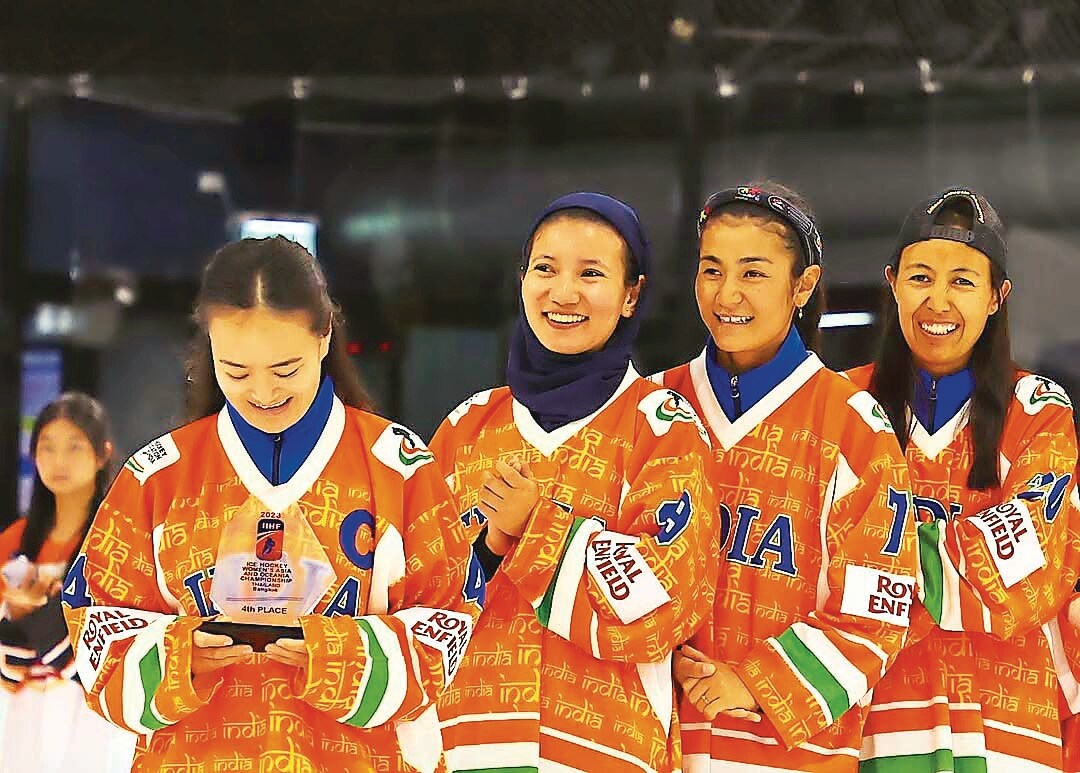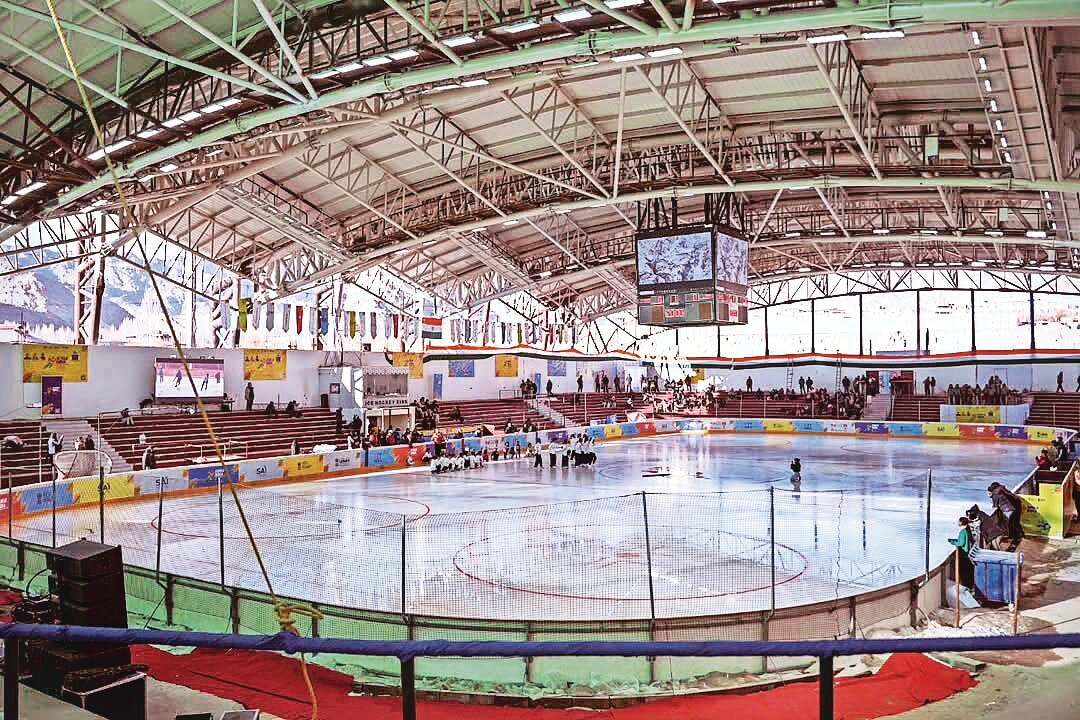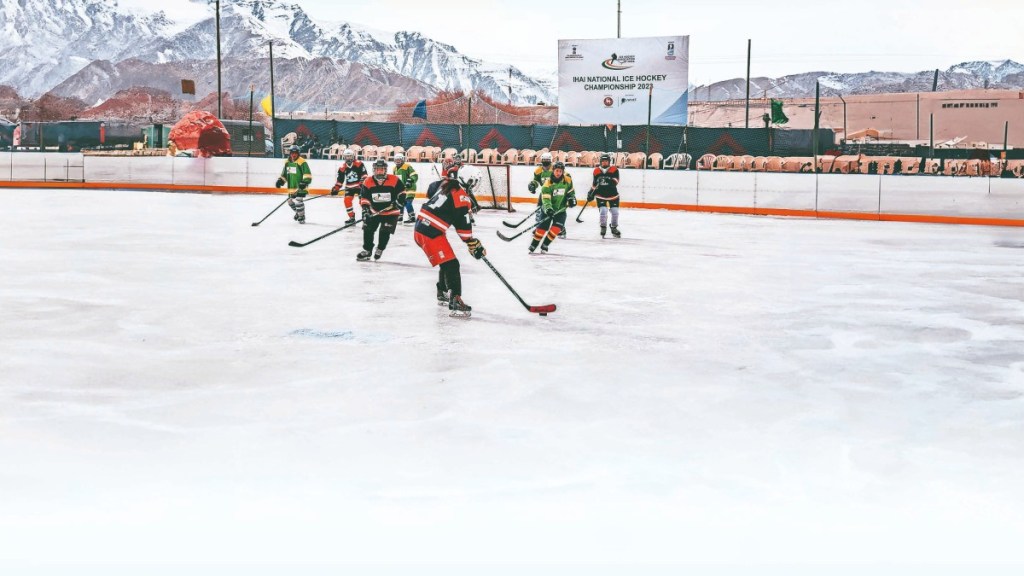Come winter, and all roads lead to Ladakh where ice hockey enthusiasts from all over the country flock to for the experience of playing in some of the highest elevated rinks in the world. The snowy heaven up north is also a place where ragtag teams of men and women scramble to make the most of the short-lived ice season (more so amid climate change) and try to put the country’s still nascent sport on the global map. The little-known players may not yet have the fame or the fortune, especially in a country where the sports scene is still dominated by cricket, but theirs is a story of grit, determination, resilience and, most importantly, passion.
“Even though we freeze in the cold, our spirits would not be broken,” says Noor Jahan, a former goalkeeper of the women’s team. “We would play some music to keep our spirits high and carry on with the task,” adds the 34-year-old player as she recalls the time when they made their international debut with the IIHF Women’s Challenge Cup of Asia Division I tournament in Chinese Taipei, 2016. Even though they performed well, they could not win any matches. Jahan, however, was named the best goalkeeper of the tournament as she went on to save 193 of 229 shots.
Now retired from active sports, Jahan works for the development of ice hockey as a coach and in the Ice Hockey Association of India (IHAI), the body controlling the sport in India, and to take the teams closer to their dream of representing the country in the 2042 Winter Olympics.
But it’s going to be an uphill task, quite literally. Even before they can practise or play, the teams have to start preparing for it a day earlier. They have to pour water to level the ice from 8 pm till 3 am in extreme temperatures that plummet to as low as –20 degrees Celsius. They do so using handpumps to extract water from a well and fill the buckets for volunteers to carry and pour them over the iced surface.
With no artificial rinks yet in place in Ladakh, the sport is primarily dependent on winters when lakes and ponds freeze and make way for rinks. Also, the season lasts for just about three months in a year and hence, the timing becomes crucial. Even though ice hockey is witnessing an increasing interest in the hilly regions of Uttarakhand, West Bengal, Sikkim, Arunachal Pradesh, Himachal Pradesh, and Jammu and Kashmir, where cold weather occurs and the game can be played outdoors, ice hockey has become intrinsic to the culture of Ladakh. While it has the advantage of seasonal ice—which in itself is facing the brunt of climate change—artificial rinks are becoming a necessity.
Ahead of the just-concluded Ice Hockey League Season 2, FE spoke with some of the prominent faces of the sport, including Jahan, Diskit Angmo and Chamba Tsetan to know a little more about their journeys and struggles, and what they feel about the future of the sport in India.
Like Jahan, Angmo and Tsetan have also been supporting ice hockey players as coaches. While Angmo, 28, recently turned to coaching (she trained 30 under-15 kids under the Learn to Play programme in a 10-day camp from December 19 to 28 last year), 30-year-old Tsetan has been coaching LTP trainees since 2017. “I must have trained around 300-400 kids since 2017, doing camps in winters. I coach two hockey teams at the moment. They are in the age group of 5-15 years,” he adds.
LTP is an introductory course recommended by the International Ice Hockey Federation (IIHF) to teach the basics of ice hockey, primarily to children between 6 and 10 years of age. The duration of these programmes ranges from 10 to 15 days. “The challenge is that we still don’t have a system in terms of the execution of the coaching. It is all based on volunteering and some youth associations being formed here and there,” Tsetan explains.
Against all odds
Ice hockey was reportedly introduced to Ladakh by the Indian Army, but was initially dominated by men. When the resources are less, gender gaps become even more visible. As the men would play and showcase their skills in the matches, the women, too, got interested. However, it was not easy for them.
Speaking with FE, Jahan shares how the women’s team has come a long way since then. “Back in the days, we were told to do a dance performance in between matches. So, women were invited for that, but not to play ice hockey,” she recalls.
They would play in a few exhibition matches in between. However, she says people eventually wanted women to stop playing ice hockey entirely, for which a movement was started with a lot of women athletes coming forward. It was led by a senior player, Stanzin Dolker, along with other women players, who eventually decided to form the Ladakh Women’s Ice Hockey Foundation (LWIHF). Under its aegis, 500 women from the region have been provided training. The association has 40 members, including 15 founders.
Angmo, whose elder brother Tsewang Gyaltsan is the captain of the men’s ice hockey team, says most women started by learning to skate, then borrowed ice hockey equipment from men to try their hand at the sport. “Most members of the men’s team were from Ladakh and seeing them, we also wanted to represent India,” she says. Seeing their grit and enthusiasm, the IHAI took note and started promoting the women, says Harjinder Singh Jindi, its general secretary. The women played their first national championship in 2013 and since then there is no looking back.
As the number of women players grew, an impressed IHAI decided to send a women’s team for the Challenge Cup of Asia in Chinese Taipei in 2016. Since then, they competed in the 2017 Asia Challenge Cup, where they finished fourth in the round robin stage and won their first ever match after defeating Philippines 4–3. In the 2019 Asia Challenge Cup Division I, they finished third ahead of Kuwait, whom they defeated 11–0. In the 2023 Asia and Oceania Championship, the team created history by reaching the semifinals but lost to Thailand. In the bronze medal match, they lost to Singapore 1–3. Jindi says there is an endeavour to promote women in ice hockey, even with the relatively less funds available with the association.

The story of the men’s team is also replete with struggles of finding funds and support, getting the equipment and gears, coaches and practising on ice available for limited time. The two teams, men’s and women’s, however, are yet to take part in the world championships organised by the IIHF and hence are unranked. They have been devoid of that opportunity because of the lack of an international-standard artificial ice rink in the country. The only one in Dehradun has been defunct since it organised the IIHF Challenge Cup of Asia in 2012. The men’s team have only participated in the IIHF Challenge Cup of Asia, a regional tournament for lower-tier hockey nations in Asia, and 2025 Asian Winter Games for the first time.
They made their international debut in 2009 at the IIHF Challenge Cup of Asia in Abu Dhabi where they finished eighth. After that, they played the Challenge Cup in 2011 where they faced defeat against Kuwait (2-39) but secured their first international victory against Macau (5–1) in the 2012 cup in Dehradun. As the team was gaining momentum, India won 7–3 against Macau and won the historic silver medal in the 2017 IIHF Challenge Cup of Asia Division I tournament.
In 2018, India won one match, against Macau (3–0), of the three matches it played. The men’s team has been participating in the Challenge Cup of Asia from 2009 to 2018, barring 2010. Their journey was put to a halt in 2018, owing to lack of funds and not being able to meet the minimum standard of having an international standard rink.
“We didn’t play after 2018 because of financial constraints. Most of the teams, which were playing Challenge Cup of Asia, qualified because they could meet the minimum playing standards —they had an international standard indoor rink… We also lost three to four years because of the Covid pandemic. Since we didn’t have an MPS in place, we couldn’t play,” says Jindi of IHAI.
The participation of the Indian men’s ice hockey team in the just-concluded 2025 Asian Winter Games in Harbin, China, faced a setback initially as the sports ministry had received two separate lists of players from different bodies, neither of which were recognised by the ministry. The Sports Authority of India (SAI) conducted selection trials and provided a list of 23 players to Indian Olympic Association (IOA) but pointed out that no effort was made to update the team pursuant to the trials.
The ministry said the final list sent by IOA contained the names of players selected by only one single faction — Ice Hockey Association of India (IHAI) which it recognises as a national sports federation (NSF). Hence, the ministry sanctioned the team finalised by IOA to participate in the event without government funding. The ministry, meanwhile, approved an 88-member contingent for the Games “at full cost to the government”, which included 59 athletes and 29 team officials. According to reports, the IOA stepped forward to bear their expenses for the journey.
Despite not having participated in an IIHF tournament since 2018 and getting just a handful of days to prepare for the Games in Harbin, due to selection delays, the Indian men’s team scripted a memorable win in their last group-stage game. They recorded their first international win since 2018 beating Macau 4-2 at the Games. They had to wind up at the group stage (Group C) losing two matches out of three — a 0-30 and a 1-19 drubbing by Hong Kong and Turkmenistan, respectively — but their win certainly underscores ice hockey’s potential in our country if given ample support. Amid all this, the Dehradun rink’s functionality is pivotal for participation in the IIHF tournaments.
On thin ice
Currently, over 80% of the players in the national team are from Ladakh. But Jindi and Jahan are of the view that for India to win medals, to have more players in the team and to make it a national sport in the truest sense, the country needs to have rinks across states. The first and only international-standard permanent indoor artificial ice rink in Dehradun has also been non-operational since 2012 due to “high operational costs”.
In the meantime, there are two permanent indoor rinks that are under construction in Leh and Kargil. While the rink in Leh is being built at a tentative cost of `50 crore, the one in Kargil is reportedly 60% complete. The government also started the Khelo India Winter Games (KIWG) in 2020 to encourage mass participation in winter sports like ice hockey. Ladakh will host the 2025 edition of the games in Leh for the second time after 2024. Incidentally, at the 2024 games, the Nawang Dorjay Stobdan Sports Complex ice rink in Leh, India’s first natural Olympic-sized ice hockey arena, made its historic debut. “Being a part of Khelo India is good for us. It will help this sport because ice hockey has only been limited to the Himalayas. We don’t want it to be only limited to Ladakh. We always wanted it to be for the country,” says Angmo.

A shot at the Olympics
All eyes are now on the 2042 Winter Olympics where the ice hockey teams want to represent the country. As for the immediate next steps that the teams need to take is to play a decentralised Union Territory (UT) League this year to get regular and competitive game practice. This applies especially to the men’s team, to qualify for the World Championships Division 4 in 2027 to be among the top 44 teams in the world, and for which infrastructure, players, and programmes have to be in place. After that, the aim is to train 12,500 children in Ladakh by 2028 through LTP programmes. For the women’s team, the agenda is to win the IIHF Asia Oceania Championships in 2029, including the under-18 level.
All these points have been highlighted in the blueprint created by Royal Enfield, the only corporate working with ice hockey in the region, and commissioned by the administration of the UT of Ladakh. “Royal Enfield’s vision for enabling the Indian ice hockey team to compete in the 2042 Winter Olympics is rooted in a strategic and long-term plan outlined in the ‘Game Changer Blueprint for the Development of Ice Hockey’. The plan has been created with deep-rooted, on-ground feedback and working with international experts and support from the International Ice Hockey Federation,” Bidisha Dey, executive director of the Eicher Group Foundation, tells FE. The company says of its total CSR budget of Rs 51.87 crore for 2024-2025, “a significant proportion is allocated towards rural sports, education and health, of which ice hockey is a crucial project”.
As per Tsetan, ice hockey urgently needs a good education programme for kids at the grassroots, coaches and infrastructure, rather than having plans for leagues or tournaments. Talking about the 2042 Olympics, Angmo says, “We can always dream about it. We will definitely push for it. I cannot guarantee, but we will definitely try to do it.” Jahan wants to train athletes in line to become goalkeeper like her. “When we say we have this dream of going to the Olympics, I want to make sure that there is a team from India in 2042,” she says.


